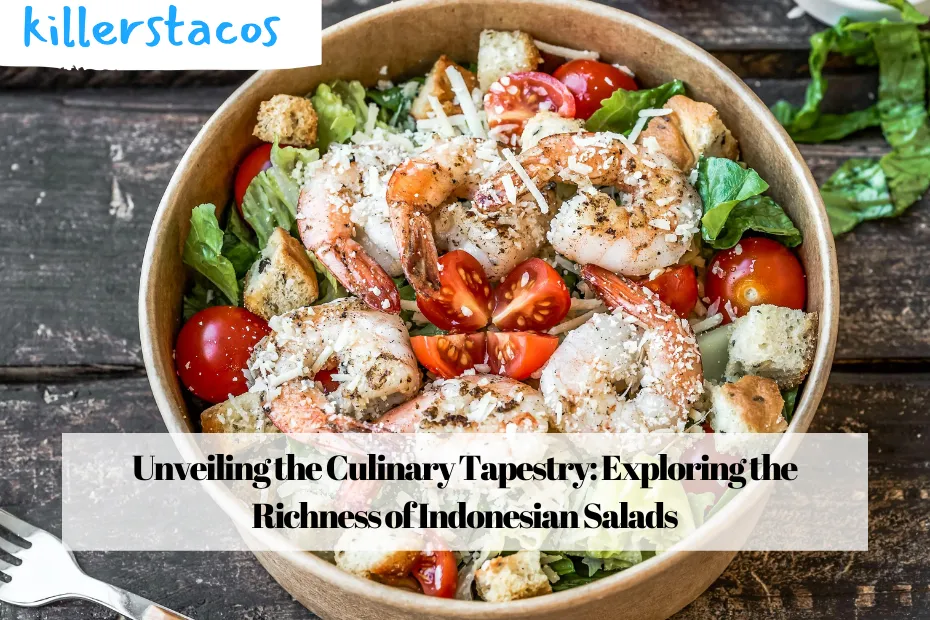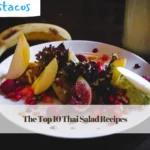1. Rujak Soto: A Fusion of Flavors from Banyuwangi
Indonesia, renowned for its diverse and flavorful cuisine, offers a tantalizing array of salads that showcase the country’s culinary ingenuity. Among these, Rujak Soto emerges as a unique blend of traditional Indonesian salad and the rich flavors of beef Soto. Originating from the enchanting region of Banyuwangi in East Java, this dish is not just a culinary delight but a cultural gem, believed to have been curated by the culinary artisan Usni Solihin in 1975.
A Symphony of Ingredients
The enchantment begins with a medley of vegetables, where water spinach (kangkung) and bean sprouts take center stage. These vibrant greens are artfully arranged alongside rice cakes and drizzled with a shrimp paste sauce, elevating the dish to a crescendo of flavors. To complete the symphony, a generous serving of soto soup is poured over this masterpiece, creating a harmony of textures and tastes that linger on the palate.

2. Selat Solo: A Culinary Fusion Rooted in History
Selat Solo beckons us into a culinary fusion that transcends time and borders. Tracing its origins to Solo in Central Java, this dish is a testament to the amalgamation of European and Javanese flavors. A harmonious blend of beef tenderloin, onions, soy sauce, and an aromatic ensemble of spices is delicately crafted. Hard-boiled eggs, mayonnaise, and an assortment of vegetables join this culinary dance, creating a dish that seamlessly straddles the realms of a main meat course, a salad, and a comforting soup.
Layers of Goodness
The preparation involves a meticulous layering of vegetables and eggs on a plate, crowned by the savory meat, and bathed in a flavorful, watery soup. The traditional touch of mayonnaise on the side adds a creamy note, transforming Selat Solo into a culinary masterpiece that tantalizes the taste buds with every spoonful.
3. Lalap: Freshness Unleashed from West Java
Lalap, also known as lalab, emerges from the lush landscapes of West Java, presenting a refreshing take on traditional Indonesian salads. While there’s no strict recipe to adhere to, Lalap often features a vibrant assortment of raw vegetables, including tomatoes, lemon basil, green eggplants, cucumbers, and cabbage. Complemented by blanched or boiled chayote, spinach, papaya leaves, and more, Lalap is a celebration of freshness served cold or at room temperature, always accompanied by the indispensable sambal terasi dipping sauce.
A Versatile Sidekick
Lalap, beyond being a standalone delight, shines as a versatile side dish, seamlessly complementing pepes, fried fish, and fried chicken. Its adaptability showcases the diversity within Indonesian culinary traditions.

4. Urap: Java’s Grated Coconut Elegance
Urap, known as urap sayur in Bali or urab, stands as a testament to Java’s culinary elegance. This traditional Indonesian salad combines steamed or boiled vegetables with a spiced grated coconut topping. The vegetable medley includes water spinach, bean sprouts, spinach, papaya leaves, cassava leaves, green beans, and cabbage, creating a visual and gastronomic masterpiece.
A Symphony of Aromas
The tantalizing topping is a harmonious blend of grated coconut, infused with the fragrances of kaffir lime leaves, coconut sugar, tamarind, chili peppers, galangal, shallots, and garlic. Urap, often served as an accompaniment, adds a burst of flavor to dishes such as nasi kuning, ayam goreng, ayam penyet, and nasi tumpang, showcasing the versatility and richness of Javanese culinary traditions.
5. Ketoprak: Tofu Salad Delight from the Streets of Jakarta
Ketoprak, a beloved street food dish hailing from Jakarta, is a harmonious marriage of textures and flavors, often likened to a tofu salad. Found in numerous carts throughout the bustling city, this dish combines fried tofu, steamed rice cakes, rice vermicelli noodles, bean sprouts, cabbage, and cucumbers. Drenched in a delectable peanut sauce and sweet soy sauce (kecap manis), Ketoprak is a symphony of tastes and textures that captivates the palate.
Unraveling the Origin Debate
While the origins of Ketoprak are a subject of debate, with some attributing its creation to Cirebon, this only adds to the intrigue surrounding this culinary masterpiece. Regardless of its origin, Ketoprak stands as a testament to the vibrant street food culture of Jakarta.
6. Rujak Cingur: A Fruit Salad with a Unique Twist
Rujak Cingur emerges as a distinctive version of Indonesian fruit salad, pushing culinary boundaries by incorporating not only tropical fruits but also a surprising ingredient – animal muzzle. Traditionally made with beef or buffalo muzzle, the fruits and vegetables are served boiled or raw, creating a unique texture. The ensemble is generously coated with a spicy Indonesian dressing, featuring shrimp paste, peanuts, sugar, and chili.

A Culinary Adventure
Rujak Cingur, with its unconventional elements, takes us on a culinary adventure that challenges conventional notions of fruit salads. The marriage of sweet, savory, and spicy flavors creates a dish that is as bold as it is delightful.
7. Asian: Pickled Delights from Jakarta and Bogor
Asinan encompasses a category of traditional Indonesian salads crafted from pickled fruit or vegetables. Believed to have originated from Jakarta for fruits and Bogor for vegetables, this dish stands as a true representative of Indonesia’s multicultural heritage. Often found in the hands of street vendors or served in traditional Indonesian restaurants, Asinan is a delightful blend of tangy and sweet flavors.
Cabbage and Cucumbers in Harmony
While Asinan can feature a variety of fruits or vegetables, cabbage and cucumbers emerge as the most common ingredients, creating a refreshing and tangy symphony that tantalizes the taste buds.
8. Karedok: Raw Brilliance on a Plate
Karedok proudly represents Indonesia’s commitment to freshness and simplicity in culinary endeavors. This traditional vegetable salad features a colorful ensemble of raw ingredients such as cucumbers, cabbage, green beans, Thai basil, bean sprouts, and eggplant. Sliced and served with a luscious peanut sauce, Karedok celebrates the raw brilliance of Indonesia’s vibrant produce.
Peanut Symphony
The peanut sauce, crafted from roasted peanuts, salt, palm sugar, and chili, distinguishes Karedok and sets it apart from its counterpart, gado-gado. The focus on raw ingredients highlights a commitment to preserving the natural flavors of Indonesia’s bountiful harvest.
9. Pecel: The Art of Flavorful Peanut Indulgence
Pecel in Indonesia encapsulates the art of marrying fragrant peanut sauce with an array of vegetables. This versatile sauce, prepared with roasted peanuts and a blend of spices including chili peppers, palm sugar, garlic, tamarind juice, shrimp paste, kaffir lime leaves, salt, and kencur, creates a dance of sweet and spicy notes.
Java’s Culinary Gem
Often associated with Java, Pecel transforms into the delectable nasi pecel when combined with rice, showcasing the culinary richness of the region. The distinctive combination of sweet and spicy flavors makes Pecel a favorite among those who appreciate the complexity of Indonesian cuisine.
10. Gado-Gado: A Timeless Indonesian Street Food Classic
Gado-gado captures the essence of Indonesian street food, presenting a mixed salad featuring an array of vegetables, eggs, tempeh, and tofu. The vegetables are delicately boiled, tossed in a nutty sauce, and crowned with crispy prawn crackers.
Evolution of Flavor
Originally crafted with cashews, Gado-Gado has evolved to predominantly feature peanuts, adapting to the changing culinary landscape while remaining a timeless cultural icon since the 16th century. This dish is not just a culinary delight but a living testament to the rich history of Indonesian street food.
Conclusion
Indonesian salads, with their diverse flavors and cultural influences, offer a tantalizing journey through the archipelago’s culinary landscape. From the savory depths of Rujak Soto to the refreshing simplicity of Karedok, each dish tells a story of tradition, innovation, and the vibrant tapestry that is Indonesian cuisine. Explore these culinary delights, and let your taste buds embark on a flavorful adventure that transcends borders and captivates the senses.
Read Also:- These Fast-Food Burritos Are Literally Burrito Bliss





